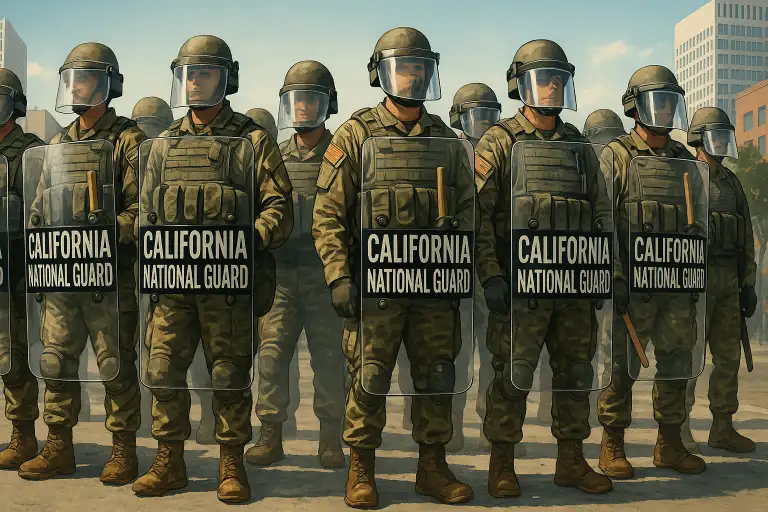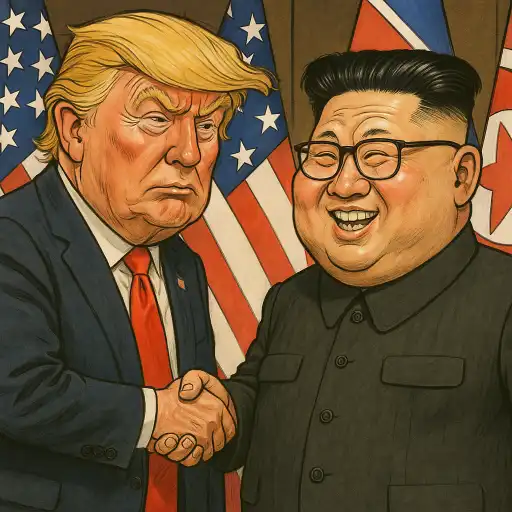How LA Became a Battlefield in America’s Democracy Crisis
The 2025 deployment of 2,000 federally activated National Guard troops to Los Angeles marked more than a security measure — it signaled a deeper transformation in how dissent is policed and democracy is governed in America.

The federalization of roughly 300 National Guard troops, later expanded to a total of 2,000, for deployment to Los Angeles in June 2025 — without a request from state or city officials — marked a turning point in the American democratic experiment. Not since the 1992 riots had the city witnessed such a show of force. But this time, the federal mobilization didn’t respond to burning buildings or mass violence. Instead, it arrived via a presidential memorandum under Title 10 of the U.S. Code, framed in terms of sovereignty, disorder, and national will.
The Trump administration justified the move as a response to “lawlessness” in the wake of sweeping immigration raids, citing violent unrest and a breakdown of order. Yet local authorities, including California Governor Gavin Newsom and Los Angeles Mayor Karen Bass, rejected that framing outright. Both emphasized that no additional military support had been requested — and that the federal presence risked inflaming tensions rather than easing them.
Unlike a formal invocation of the Insurrection Act, which would have explicitly authorized the use of military force to quell civil disorder, this deployment existed in a legal gray zone: National Guard units placed under federal control, but without the constitutional and political scrutiny such declarations typically demand. The move sidestepped traditional checks and blurred the boundary between emergency response and executive theater.
At the heart of the controversy lies a deeper philosophical dilemma: Can a democracy maintain its legitimacy when protest is increasingly treated as threat, and military posture replaces civic dialogue? Political theorist Giorgio Agamben warns of the “state of exception” — a condition in which constitutional norms are suspended not by necessity, but by design. When governments govern by exception, the danger is not chaos but order — an order imposed from above, outside the bounds of mutual consent.
For many observers, the events in Los Angeles raise alarms not only about federal overreach, but about the slow erosion of democratic norms under the guise of legality. The question now confronting the nation is not whether the law was followed — but whether the law, when unmoored from its democratic purpose, can still protect the people it was meant to serve.
Legal Ambiguity and Executive Power
Despite stopping short of invoking the Insurrection Act, President Trump’s June 7 memorandum ordered the deployment of 2,000 California National Guard troops under Title 10, Section 12406 of the U.S. Code — a rarely used federal statute that permits the president to assume command of state-based Guard units in the face of invasion, rebellion, or the obstruction of federal law.
What makes this move legally fraught is the discrepancy between statutory justification and on-the-ground conditions. California Governor Gavin Newsom explicitly rejected the federal assessment, calling the deployment “purposefully inflammatory” and warning that it would escalate — not contain — tensions. Local law enforcement reported no breakdown in order, and experts across the political spectrum questioned whether the protests met the threshold of “rebellion” required by the statute.
The federalization of the Guard places these troops in a gray zone: while no longer under state authority, they are still constrained by the Posse Comitatus Act, which prohibits the use of federal military personnel in domestic law enforcement. National Guard troops under Title 10 cannot conduct arrests or suppress protests directly. However, they can support federal agencies — such as Immigration and Customs Enforcement — by securing federal buildings and shielding agents during enforcement actions. This effectively embeds military presence into civilian protest environments, without formally declaring martial law.
Critics argue that this maneuver blurs the distinction between legal restraint and performative force. While technically within the boundaries of federal law, the deployment functions politically as a spectacle of control — a show of strength designed to reframe protest as rebellion. Vice President J.D. Vance and senior advisor Stephen Miller both referred to the demonstrations as “anti-sovereignty actions,” invoking language that casts dissent as a threat to the state, not a dialogue within it.
This rhetorical escalation serves short-term political goals, but reflects a longer trend: the expansion of executive power under the cover of legality. In this context, the true danger is not the violation of law, but the slow erosion of the legal order itself — where extraordinary measures no longer appear extraordinary, and constitutional boundaries are reinterpreted through partisan lenses.
The Rhetoric of Rebellion and the Performance of Control
While the legal mechanics of the National Guard deployment may appear technical, the language used to justify it reveals a deeper political intent. In public remarks, administration officials repeatedly described the protests as “insurrectionist,” “anti-sovereignty,” and “a threat to national integrity.” This rhetorical strategy reframes peaceful protest not as protected expression, but as existential defiance — a move that delegitimizes dissent by conflating it with criminal rebellion.
Such framing is not new, but its timing is telling. In a moment of heightened political polarization and demographic anxiety, the administration’s invocation of “law and order” is less about public safety than about symbolic dominance. The deployment becomes not merely a logistical response to unrest, but a performance of state authority, choreographed to send a message of control — both to the protesters and to a political base animated by visions of a nation under siege.
Political theorist Jacques Rancière has described this process as the “partition of the sensible” — the drawing of boundaries around who is allowed to speak, protest, and be heard within a polity. By labeling immigrant-led protests as threats to sovereignty, the administration not only marginalizes their legitimacy, but recasts their very presence as outside the bounds of political speech.
This is how authority hardens into spectacle: not through formal declarations of martial law, but through the cultural and visual grammar of power — uniforms, fences, helicopters, and the constant repetition of a single idea: they are not citizens expressing grievances; they are enemies of order.
The danger here is not just in how the state responds to dissent, but in how it narrates that dissent into meaninglessness. When protest is no longer recognized as a civic act, but as a precursor to rebellion, the social contract itself begins to unravel — replaced by a logic of suspicion, control, and exclusion.
Democratic Legitimacy and the Right to Dissent
At the heart of any constitutional democracy lies a fragile compact: that those who govern do so with the consent of the governed, and that political disagreement is not only tolerated but protected. When that compact frays — when protest is reframed as insurrection, and dissent becomes equated with disloyalty — the legitimacy of state power comes under ethical and constitutional scrutiny.
In liberal democratic theory, the right to dissent is not an afterthought. It is a foundational principle — a necessary condition for public accountability and political renewal. From civil rights marches to anti-war protests, the American political tradition has been shaped as much by contestation as by consensus. To govern in a democracy, then, is not merely to enforce order, but to absorb conflict without resorting to coercive spectacle.
Yet in Los Angeles, the state’s response has reversed this logic. The federal deployment did not respond to violence; it anticipated it, casting suspicion over protest before it materialized. In doing so, the administration redefined protest itself as a preemptive threat — something to be monitored, contained, and neutralized.
This preventive framing erodes not only civil liberties, but also the philosophical legitimacy of governance. If the state alone defines when dissent becomes danger, then the social contract becomes unilateral. Power no longer flows from the people upward, but from the executive downward — enforced through fear, not trust.
The irony is sharp: in the name of protecting democratic order, the state begins to undermine the very freedoms that make such order legitimate. The consequence is not just political polarization, but a deeper civic trauma: a public that no longer believes protest is meaningful, and a government that views disagreement not as a challenge to be engaged, but as a threat to be controlled.
Power, Memory, and the Democratic Threshold
Democracy does not collapse in a single gesture. It erodes incrementally — each time emergency becomes routine, each time protest is recoded as rebellion, and each time legality is used not to protect liberty, but to discipline it.
In both the United States and South Korea, we have recently witnessed moments when the machinery of the state turned inward: when civilian unrest was met not with deliberation, but with deployment; not with dialogue, but with deterrence. In Los Angeles, as in Seoul, the rationale was familiar — the preservation of order, the protection of sovereignty, the containment of threat. But beneath these justifications lies a more troubling pattern: the transformation of democratic dissent into a security problem, and the quiet normalization of military logic within civilian life.
This is not merely a political phenomenon. It is a philosophical rupture. As Giorgio Agamben warned, the state of exception, once normalized, ceases to be an exception at all. It becomes the new mode of governance — law without justice, legality without legitimacy. Carl Schmitt’s insight that the sovereign is “he who decides the exception” is no longer a relic of 20th-century thought; it is a present condition, visible in every memorandum that militarizes protest and every executive act that silences dissent under the guise of protection.
For Koreans, the return of such logics is not abstract. In 2024, amid fears of electoral backlash, the contemplation of martial law by state actors revived the specter of 1980 — not just in its legality, but in its betrayal. It reminded us that the forms of democracy can persist even as their meaning decays. The law may remain intact while its spirit is hollowed out by fear, its institutions repurposed not to empower citizens, but to manage them.
And herein lies the ethical core: a democracy that views its people as a threat is already on the threshold of something else — something post-democratic, even if procedurally constitutional. The preservation of democratic life, then, is not guaranteed by courts or codes alone. It rests on memory, vigilance, and a refusal to let the logic of exception define the ordinary.
In the end, democracy is not inherited. It must be rehearsed — again and again — through protest, participation, and above all, through the enduring insistence that power remain answerable to those over whom it is exercised.



Comments ()